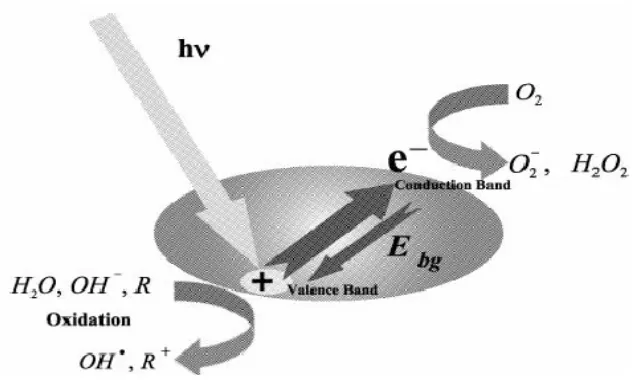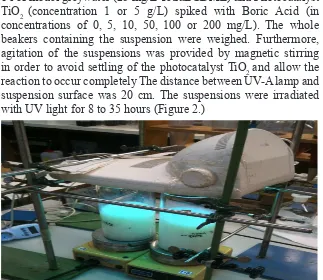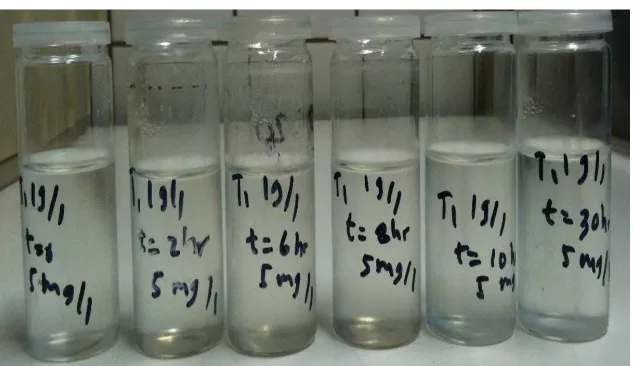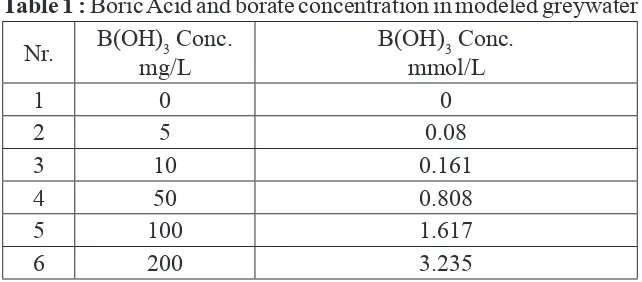IMPACT OF BORIC ACID ON PHOTOCATALYTIC OXIDATION
T. Muhammad Ashari
Lecturer at Department of Environmental Engineering UIN Ar-Raniry
Email: t.m.ashari@gmail.com
ABSTRACT
Greywater reuse is considered as one solution in solving water scarcity problem in the world because it is less contagious and less polluting to environment than the entire municipal wastewater. Greywater is easier to treat and reuse it. One possibility to treat greywater is using constructed wetland followed by an advanced oxidation process such as photocatalytic oxidation. This process removes organic materials in waste water by oxidation via hydroxyl radicals. There was discussion about the effects of the solution inorganic matrix such as borate on the photocatalytic oxidation. Borate a common constituent of greywater was reported to inhibit photocatalytic oxidation. This research tried to determine the effect of boric acid on photocatalytic oxidation spiked with boric acid in concentration of 5 to 200 mg/L using aqueous TetraEGDME solutions. It was found that there is no inhibition of photocatalytic oxidation process when boric acid is present and pH is acidic (about 4-5).
Key words: greywater reuse, photocatalytic oxidation,inhibition, boric acid,
1. Introduction
Water is one of the most important elements for living and one of the most precious resources in earth. Water is perquisite of life; there is no organism which can live without water. Not only human beings, but all other living creature on earth highly depends on water. We rely on water in almost all aspects in our live. The increasing demand of water creates the problem both in quality and quantity of water. In many parts of the world, water scarcity has become a major problem. In the last couple of decades, the rapid growth of population, industry, megacities, and urbanization has increased the need of water. Water promises to be to the 21st century what oil was to the 20th century:
Reusing water is a possible alternative in many parts of the world. The expression of wastewater could mean water which is not
used and wanted anymore and there is no proit from this water.
Wastewater content’s around 99% water and the rest is solid waste. Wastewater has become a valuable commodity compared to years ago where wastewater was loaded just as a waste without any value. In general, the domestic wastewater can be divided into two categories, which are black water and greywater. Black water is water from toilets which contains urine and fecal matter. Greywater is water from domestic activities such as laundry, dishwashing, and bathing. Lately, to simplify the system and economize the conventional wastewater treatment an innovative system has been developed to separate black water from greywater and then treat them separately.
Unlike black water, greywater is less contagious and less polluting to environment. There are many things which are
contained in greywater; Eriksson et al. (2009) have identiied 191
organic substances within greywater. These organic substances are mainly long chain aliphatic carboxylic acid. They also found organic compounds like e.g. tert.-butylhydroxyanisol (BHA), an endocrine disrupting chemical (EDC). In addition, because of different activities in its production, greywater exhibit large variations for several parameters. According to Eriksson et al (2002), greywater show spans in Biochemical Oxygen Demand (BOD) of 5 to 1460 mg/L, in Chemical Oxygen Demand (COD) of 13 to 8000 mg/L, in pH of 5 to 10, in turbidity of 15 to 240 NTU and in suspended solids of 17 to 330 mg/L.
Recently, many technologies have been developed to treat
greywater such as basic coarse iltration, chemical and biological
Figure 1 Schematics of the electron-hole generation in a photocatalyst particle
Recently, there were several investigations about the effect of the inorganic solution matrix on the degradation of contaminants by photocatalytic oxidation process. Therefore, the greywater
matrix such as bicarbonate or borate can affect the eficiency of
PCO. Many inorganic compounds contained in wastewater reduce
the eficiency of the photocatalytic process. Bicarbonate as well as borate has been shown to deteriorate the process eficiency,
Schmelling et al. (1997). As greywater may also contain boron compounds from detergents, this experiment was performed to test different borate concentrations for their impact on PCO.
2. Methods
2.1. Materials and Instruments
studio HB 171) with a maximum emission wave length of 352 nm other instruments is Beaker glass 2 L volume.
2.2. Irradiation Experiment
The experiments were conducted in laboratory-scale. Before conducting the PCO process, a solution of 25 mg/L TetraEGDME in 1 L deionized water, boric acid into which the photocatalyst powder TiO2 was suspended. PCO process was investigated in glass vessel reactors. The reactor was a 2-litre glass cylindrical beaker, with diameter of 11 cm, and a height of 24 cm. It contained 1 l of model greywater (25 mg/L TetraEGDME) and Photocatalyst TiO2 (concentration 1 or 5 g/L) spiked with Boric Acid (in concentrations of 0, 5, 10, 50, 100 or 200 mg/L). The whole beakers containing the suspension were weighed. Furthermore, agitation of the suspensions was provided by magnetic stirring in order to avoid settling of the photocatalyst TiO2 and allow the reaction to occur completely The distance between UV-A lamp and suspension surface was 20 cm. The suspensions were irradiated with UV light for 8 to 35 hours (Figure 2.)
2.3. Sampling Procedure
Samples of 60 ml were taken at different times. Before samples were taken, the reactor was weighed again. The loss of water due to evaporation was replaced with deionized water prior to sampling. After sampling the solution was weighed again for the next irradiation procedure. TiO2 concentration was kept constant for the following irradiation period. In addition, pH of samples was measured to determine the change of pH after irradiation. In order to make the photocatalyst TiO2 in the sample settle, samples were kept in refrigerator and stored for several days. After a part of the photocatalyst settled, supernatants were decanted and centrifuged
(30 minutes, 5000 rpm). Centrifugation supernatants (igure 4.2)
were analyzed for TOC.
Figure 3. Samples after centrifugation
2.4. Analyses
3. Results And Discussion
After TOC analysis, it was found that TOC of the TetraEGDME solution used in this study varied in the range of 12 - 16 mg/L. These numbers seem adequate to simulate a greywater
efluent from constructed wetland.
The concentration of 0.4 mg/L boron in greywater is equal to a concentration of 0.037 mmol/L borate (assuming that all boron is contained in borate/boric acid). In order to model the concentration of borate in greywater, ranges of boric acid from 0 mg/L to 200 mg/L were used in this experiment. Borate concentration in the investigated model wastewaters are shown in table 31. The table below shows the boric acid concentrations applied in the model wastewaters expressed as mass and as molar concentrations.
Table 1 : Boric Acid and borate concentration in modeled greywater Nr. B(OH)3 Conc.
mg/L
B(OH)3 Conc. mmol/L
1 0 0
2 5 0.08
3 10 0.161
4 50 0.808
5 100 1.617
3.1. Irradiation Experiment
The effect of boric acid present in model greywater on PCO
is shown in igures 4 - 5
Figure 4. Photo Catalytic Oxidation of 25 mg TetraEGDME with 1 g/L TiO2 and B(OH)3 concentrations of 0, 10 and 200 mg/L
Based on igure 5, when t = 0, initial TOC of solution was
13.2 mg/L. Furthermore, after 10 hours irradiation of model greywater containing no boric acid, the concentration of TOC decreased from13.2 mg/L to 6.6 mg/L. Almost 50% of organic carbon has thus been mineralized. A similar amount of 60% of organic carbon in the model wastewater containing 10 mg/L boric acid has been degraded after a similar period of 9 hours. From the model greywater containing 200 mg/L boric acid 65% of organic carbon were degraded after 10 hours irradiation. There is deviation at 50mg/L of boric acid and 1 g/L TiO2, the organic carbon was degrading too much faster compare to others. Contrasting to literature (Schmelling et al. 1997) these data do not show any inhibition of PCO of TetraEGDME of boric acid. However, this investigation has been executed at much lower pH (4 - 4.5) than
the study of Schmelling et al. (1997) as described in igure 5.1 and
5.2. Moreover the organic compounds were different.
Figure 7: Photo Catalytic Oxidation of 25 mg TetraEGDME with 5 g/L TiO2 and B(OH)3 concentrations of 5, 50 and 100 mg/L
Based on igure 5.3, at a TiO2 concentration of 5 g/L, around 70% of organic carbon in solution was mineralized after 10 hours. This was observed in all three solutions with different concentrations of boric acid (0, 50 and 100 mg/L.
In this experiment with 5 g/L of TIO2, 70% of organic carbon has been removed after 10 hours irradiation. It can be concluded that organic carbon was degraded 20% faster than with 1 g/L of TiO2. Although 5 g/L of TiO2 leads to a faster removal of organic carbon than 1 g/L of TiO2. The increase of degradation rate was not
too signiicant, however.
From all igures above, it can be seen that at any concentration
4.
ConclusionBoric acid / borate have been reported in literature to inhibit the PCO process. As boron is also present in greywater, it might
deteriorate PCO eficiency when treating greywater with this
process. Boron concentration in biologically pretreated greywater
was about 0.4 mg/L. Investigations on the inluence of boric acid
at concentrations of 5 - 300 mg/L on PCO of a model wastewater with TetraEGDME (TOC concentration 12-16 mg/L) revealed that there was no PCO inhibition in the presence of 1 and 5 g/L TiO2. The higher concentration of catalyst resulted only in a slightly
higher PCO eficiency. Moreover, pH is one of the conditions
that affect PCO process. This experiment was conducted in the pH range of 4-5 and it can be concluded that boric acid does not inhibit the PCO process under acidic conditions. There was a slight
increase of pH during PCO. It still has to be clariied whether boric
Bibliography
Dhas, P. , Gulyas, H. and Otterpohl, R. (2015) Impact of Powdered Activated Carbon and Anion Exchange Resin on Photocatalytic Treatment of Textile Wastewater. Journal of Environmental Protection, 6, 191-203. doi: 10.4236/ jep.2015.63020.
Ericksson, Henrik R. Andersen, Toke S. Madsen, Anna L. (2009) Greywater pollution variability and loadings. Ecological Engineering, Volume 35, Issue 5, May 2009, Pages 661– 669.
Gulyas H., Solar (2014) Heterogeneous Photocatalytic Oxidation for Water and Wastewater Treatment: Problems and Challenges. Journal of Advanced Chemical Engineering Li, Z., Gulyas, H., Jahn, M., Gajurel, D. R. & Otterpohl, R. (2003)
Greywater treatment by constructed wetland in combination with TiO2-based photocatalytic oxidation for suburban and rural areas without sewer system. Water Sci. Technol. 48(11), 101–106.
Otterpohl, R., Albold, A. & Oldenburg, M. (1999) Source control in urban sanitation and waste management: ten systems with.
Rivero, M.J., Parsons, S.A., Jeffrey, P., Pidou, M., Jefferson, B., (2006) Membrane chemical reactor (MCR) combining
photocatalysis and microiltration for grey water treatment.
Water Sci. Technol. 53, 173e180
Schmelling, D.C., Gray, K.A., Vamat, P.V., (1997) The inluence of





